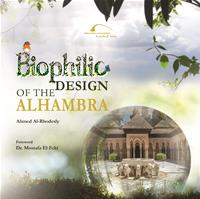The BA Publishes the Book The Biophilic Design of the Alhambra
Posted on

The BA Center for Islamic Civilization Studies has published the book The Biophilic Design of the Alhambra by the researcher and architect Ahmed al-Rhodesly. The book deals with Alhambra Palace's architecture in Granada from a new perspective concerned with biophilic design, as the author seeks to prove that Alhambra architecture epitomizes a successful biophilic design that can positively impact human health and well-being. The book also attempts to link architectural heritage and health sciences by exploring the concept of biophilia and biophilic design, interpreting the dialogue between nature and the cultural and structural features of Alhambra, recognizing the potential impacts of the “Fourteen Biophilic Design Styles” proposed by the Terrapin Bright Green Foundation on human health and well-being, and investigating the presence of these patterns in the architecture of Alhambra in Granada, as well as presenting five examples of similar designs to Alhambra from around the world.
Alhambra is an excellent example of the fulfillment of the fourteen biophilic design styles. The design of Alhambra expresses immediate, physical, and trans-nature influences including plants, water, and animal life, as well as breeze, sounds, and smells. Common examples of such influences include the gardens, courtyards, patios, fragrant plants, fountains, bodies of water, and natural ventilation. Alhambra's design drew from nature in an organic, inanimate and indirect way, thus shapes, materials, and colors appeared as geometric decorations, inscriptions, walls decorated with stucco, and wooden ceilings. Alhambra also dealt with the spatial formations in nature that stimulate the human innate and acquired desire to be able to see beyond his immediate surroundings. Moreover, the similar examples to Alhambra from around the world included in the book reveal how the biophilic essence of the architecture of the Alhambra in Granada has a global impact, which proves that the original Alhambra's representation of the characteristics of architectural heritage did not disappear with the end of its historical era.
Therefore, the book explains how biophilic design can be applied through a realistic example with unique cultural and historical dimensions, in addition to highlighting the expected impact of Alhambra architecture on the health and well-being of its visitors. Consequently, architects and planners can benefit from this model and work to integrate the biophilic design approach into built environments to enhance human physiological and psychological well-being, all of which is vital to human survival.